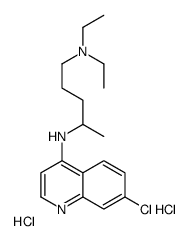3545-67-3
| Name | 4-N-(7-chloroquinolin-4-yl)-1-N,1-N-diethylpentane-1,4-diamine,dihydrochloride |
|---|---|
| Synonyms |
Chloroquine hydrochloride
EINECS 222-592-1 Chloroquine HCl Chloroquine dihydrochloride Aralen hydrochloride |
| Description | Chloroquine dihydrochloride is an antimalarial and anti-inflammatory agent widely used to treat malaria and rheumatoid arthritis. Chloroquine dihydrochloride is an autophagy and toll-like receptors (TLRs) inhibitor. Chloroquine dihydrochloride is highly effective in the control of SARS-CoV-2 (COVID-19) infection in vitro (EC50=1.13 μM)[1][2][3][4]. |
|---|---|
| Related Catalog | |
| In Vitro | Chloroquine dihydrochloride (20 μM) inhibits IL-12p70 release and reduces Th1-priming capacity of activated human monocyte-derived Langerhans-like cells (MoLC). Chloroquine dihydrochloride (20 μM) enhances IL-1–induced IL-23 secretion in MoLC and subsequently increases IL-17A release by primed CD4+ T cells[1]. Chloroquine dihydrochloride (25 μM) suppresses MMP-9 mRNA expression in normoxia and hypoxia in parental MDA-MB-231 cells. Chloroquine dihydrochloride has cell-, dose- and hypoxia-dependent effects on MMP-2, MMP-9 and MMP-13 mRNA expression[2]. TLR7 and TLR9 inhibition using IRS-954 or Chloroquine dihydrochloride significantly reduces HuH7 cell proliferation in vitro[3]. Chloroquine dihydrochloride (0.01-100 μM; 48 hours) potently blocked virus infection (vero E6 cells infected with SARS-CoV-2) at low-micromolar concentration (EC50=1.13 μM). Chloroquine dihydrochloride blocks virus infection by increasing endosomal pH required for virus/cell fusion, as well as interfering with the glycosylation of cellular receptors of SARS-CoV[4]. |
| In Vivo | Chloroquine dihydrochloride (80 mg/kg, i.p.) does not prevent the growth of the triple-negative MDA-MB-231 cells with high or low TLR9 expression levels in the orthotopic mouse model[2]. TLR7 and TLR9 inhibition using IRS-954 or Chloroquine dihydrochloride significantly inhibits tumour growth in the mouse xenograft model. HCC development in the DEN/NMOR rat model is also significantly inhibited by Chloroquine[3]. |
| References |
| Molecular Formula | C18H28Cl3N3 |
|---|---|
| Molecular Weight | 392.79400 |
| Exact Mass | 391.13500 |
| PSA | 28.16000 |
| LogP | 6.48760 |
| Hazard Codes | Xi |
|---|
